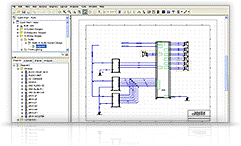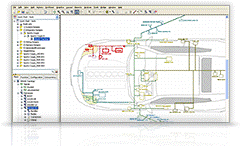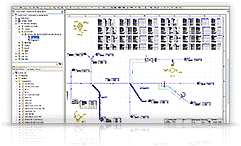Capital Wiring Essential and Capital Harness Essential tools can be used individually, or deployed together allowing wiring design data to flow seamlessly into the associated harness designs reducing effort and minimizing the risk of errors.
Capital Wiring Design Essential
Capital Wiring Designer Essentials software provides a graphical environment for creating wiring diagrams. Full electrical design authoring is made easy via an intuitive user interface and electrically intelligent symbols. Built-in electrical intelligence automates many design tasks.
Validate designs using integrated electrical behavior and automation
Simulate to design faster
Use simulation to check and validate designs as they are created. Eliminate errors faster and earlier in the design process.
Design with confidence
Our streamlined, yet full-featured tool lets you design with confidence. Enjoy customizable drawing styles and built-in intelligent libraries for components, symbols and simulation models. Integrate with your MCAD systems for 3D harness routing and wire length back-annotation.
Automate reports and documentation
Automatically generate reports for wires, connectors and devices used in your design. Diagram device and wire index tables. Add full sheet and zone referencing to drawings, and update them automatically as you make changes.
Monitor metrics for early correction
Use analysis to catch issues early in the design process where they are least time consuming and expensive to correct.
Prevent errors and save time
Eliminate mundane tasks and take advantage of automation to cross-reference multi-sheet parts and wires. The intuitive and productive circuit design and harness development environment make adoption simple.
Improve revenue
Easily deploy the tool into existing processes and environments. Typically, return on investment (ROI) is achieved in less than 12 months.
Easily scale when needed
Leverage the Capital Essentials suite, which is designed for rapid deployment and easy installation, to achieve dramatic ROI using powerful functionality. Use design and harness tools individually or deploy them together. Allow wiring design data to flow seamlessly into the associated harness designs to reduce effort and minimize the risk of errors. If needed, users can employ seamless upgrades to the full Capital software suite.
Learn more about Capital Essential Wiring Design ›Download PDF brochure ›
Capital Essential and Capital Work Together
Capital Essential data is compatible with Capital, allowing companies to operate with a mixed Capital Essential and Capital environment. Or, companies may start with Capital Essential and upgrade to Capital as the design organization grows. View Comparison
Capital Wiring Essential and Capital Harness Essential tools can be used individually, or deployed together allowing wiring design data to flow seamlessly into the associated harness designs reducing effort and minimizing the risk of errors.
Capital Harness Design Essential
Capital Harness Designer Essentials software provides a graphical environment for creating harness and formboard drawings. Its intuitive user-interface makes harness design authoring easy.
Speed harness design and eliminate delays found in traditional design processes
Deploy rapidly to meet your goals
Use individually or deploy it with Capital Wiring Designer Essentials, allowing wiring design data to flow seamlessly into the associated harness designs to reduce effort and minimize the risk of errors. Validate designs using integrated electrical behavior and design automation with part selection.
Design with confidence
Integrate wiring, harness and mechanical computer-aided designs to promote reuse, data coherency and cross-domain collaboration. Automate generation of connector, wire and splice tables. Calculate wire-lengths, include terminal and connector add-on/knockoff values. Integrate wiring and harness design to import wires, connectors and splices. Back-annotate wire lengths. Use built-in intelligent libraries for components and symbols.
Automate reports
Automatically generate harness manufacturing reports, including bills of materials (BOMs) and cutting lists.
Monitor metrics for early correction
Use analysis to catch issues early in the design process where they are least time consuming and expensive to correct.
Automate tasks
Automatically populate connector tables as wires are added, terminals selected and wire tables generated.
Speed up your harness design process
Implement a powerful automated parts selector that automatically configures and selects terminals, seals and wires for each connector, including allowances for add-ons and knockoffs. This eliminates a major source of problems found in the traditional design process.
Generate documentation quickly
Once a harness is complete, use the powerful reporting capabilities to generate the documentation required for manufacturing. The reports are automatically generated directly from the design drawing, ensuring fast and accurate information. This can significantly reduce production lead times and prevent manufacturing errors.
Use flexible formboard layout choices
Employ rapid graphical layout and engineering of harness and formboard designs. Draw harnesses non-scaled or full-sized using formboard layout capabilities.
Improve revenue
Easily deploy the tool into existing processes and environments. Typically, return on investment is achieved in less than 12 months.
Easily scale when needed
Leverage the Capital Essentials suite, which is designed for rapid deployment and easy installation, to achieve dramatic ROI using powerful functionality. Use design and harness tools individually or deploy them together. Allow wiring design data to flow seamlessly into the associated harness designs to reduce effort and minimize the risk of errors. If needed, users can employ seamless upgrades to the full Capital software suite.
Capital Essential and Capital Work Together
Capital Essential data is compatible with Capital, allowing companies to operate with a mixed Capital Essential and Capital environment. Or, companies may start with Capital Essential and upgrade to Capital as the design organization grows. View Comparison
Capital Logic
Create logical and wiring schematic designs interactively or using auto-generation facilities. Learn more ›
Capital Integrator
Optimize the architectural layout of functionality and cabling for cost, weight, and harness variants. Learn more ›
Capital Harness XC
Optimize the architectural layout of functionality and cabling for cost, weight, and harness variants. Learn more ›
Capital In-Depth
Wiring Design–A Choice of Two Processes
CAPITAL provides a choice of two different wiring design processes – the interactive design flow process or the generative design flow process.
Interactive Wiring design process
The Interactive Wiring design process is based on the Capital Logic and Capital HarnessXC applications to provide a full electrical design capability from logical schematics through to fully detailed and costed harness drawings.
The interactive design flow process is based on the electrical engineers creating the definition of both logical schematic connectivity – for example, connect pin 27 of the engine ECU with pin 5 of the power-systems ECU – plus creating the wiring definition of the schematic connectivity – for example, the connections between pin 27 and pin 5 is defined by 3 physical wires passing through two inline connectors.
Generative design process
The Generative design process is based on the Capital Logic, Capital Integrator and Capital HarnessXC applications to provide a full electrical design capability from logical schematics through physical/topological wiring generation, and onto fully detailed and costed harness drawings.
With the generative flow, electrical engineers provide the definition of the logical schematic connectivity – for example, connect pin 27 of the engine ECU with pin 5 of the power-systems ECU – plus providing a physical/topological layout of the car or aircraft – for example, cables can only be routed along a defined network of cable paths. CAPITAL can integrate the logical and physical information to automatically generate the wiring definition, including auto-generated wiring diagrams, allowing the same logical designs to be reused in a succession of different physical designs.
Data-centric Backbone
Fundamental to the philosophy of Capital is the belief that design data management is central to solving the problem of electrical design complexity. So, in addition to providing the drawing and design definition functionality required for each phase of the design process, Capital goes one step further – by providing a data-centric backbone that integrates each and every part of the design process.
Data-centricity is the key feature that differentiates CAPITAL from other design tools, providing a step change in design speed and quality by automating many steps in the design process, streamlining the flow of information as the design matures, and eliminating many of the time-consuming and error-prone data-entry tasks required with traditional design tools.
For many organizations, significant inefficiencies exist in their electrical design process, particularly regarding exchange of data from one step in the process to the next, and in the implementation of design changes. These inefficiencies affect quality and impact the overall design cycle time and the manpower required to complete each design. The use of CAPITAL’s streamlined electrical design processes can provide major improvements to quality, cost and design cycle time, allowing companies to confidently meet the challenges of global competition.
Project and process management
Project norms such as naming conventions, design rule check patterns and diagram style-templates can be defined and automatically applied. Process constraints such as release management sequence, component usage and analysis scripts can be mandated. Integration with workflow tools is also available.
Design change management
The data-centric architecture of CAPITAL is designed to facilitate change processes. Multiple change management capabilities are provided such as tabular & graphical difference reports; version management; compatibility control (“build lists”); and aerospace-effectivity tracking.
Intuitive electrical simulation and analysis
Multiple capabilities are available ranging from simple subsystem behavior simulation, through DC and transient simulation, to whole vehicle validation and failure analysis. Fully integrated with the design environment, these tools have been developed for use by all design engineers, not just analysis specialists.
Deep integration with MCAD platforms
Such as Dassault Systèmes’ CATIA V5 and Siemens NX. Data can be shared either offline or in a live “connected” mode, which aids visualization. Design changes can be trapped and reconciled. PDM integration is also available, for example to slave component library data or to vault released designs.
For many organizations, significant inefficiencies exist in their electrical design process, particularly regarding exchange of data from one step in the process to the next, and in the implementation of design changes. These inefficiencies affect quality and impact the overall design cycle time and the manpower required to complete each design. The use of Capital’s streamlined electrical design processes can provide major improvements to quality, cost and design cycle time, allowing companies to confidently meet the challenges of global competition.
Cross-organization communication
CAPITAL supports cross-organization data communication at several points in the design flow. Multiple data formats are supported, and specialized functionality such as part number translation is provided.
Harness engineering
CAPITAL provides powerful automatic harness engineering and validation functionality, for example by automatically selecting library components or validating splice balancing rules. Modern construction methods such as modular (subassembly) build are fully supported. Very detailed harness costing is available from a model containing over 300 design and process parameters.
Configuration capture and composite (superset) data management
Configuration logic can be authored or imported. All design, simulation and reporting activities are undertaken within this composite environment, whether at the full vehicle or individual harness level. This critical capability further supports easy and robust change management.
Diagram synthesis
Capital can automatically generate diagrams from data, so freeing engineers to work on creative design tasks. Style templates can be applied, and drawing contents are laid out for maximum readability.
With these critical process management foundations in place, CAPITAL supports electrical design process flows from logical subsystem design, through sub-system integration and wire harness engineering, onto harness manufacturing and provision of after-sales service documentation & diagnostics.






